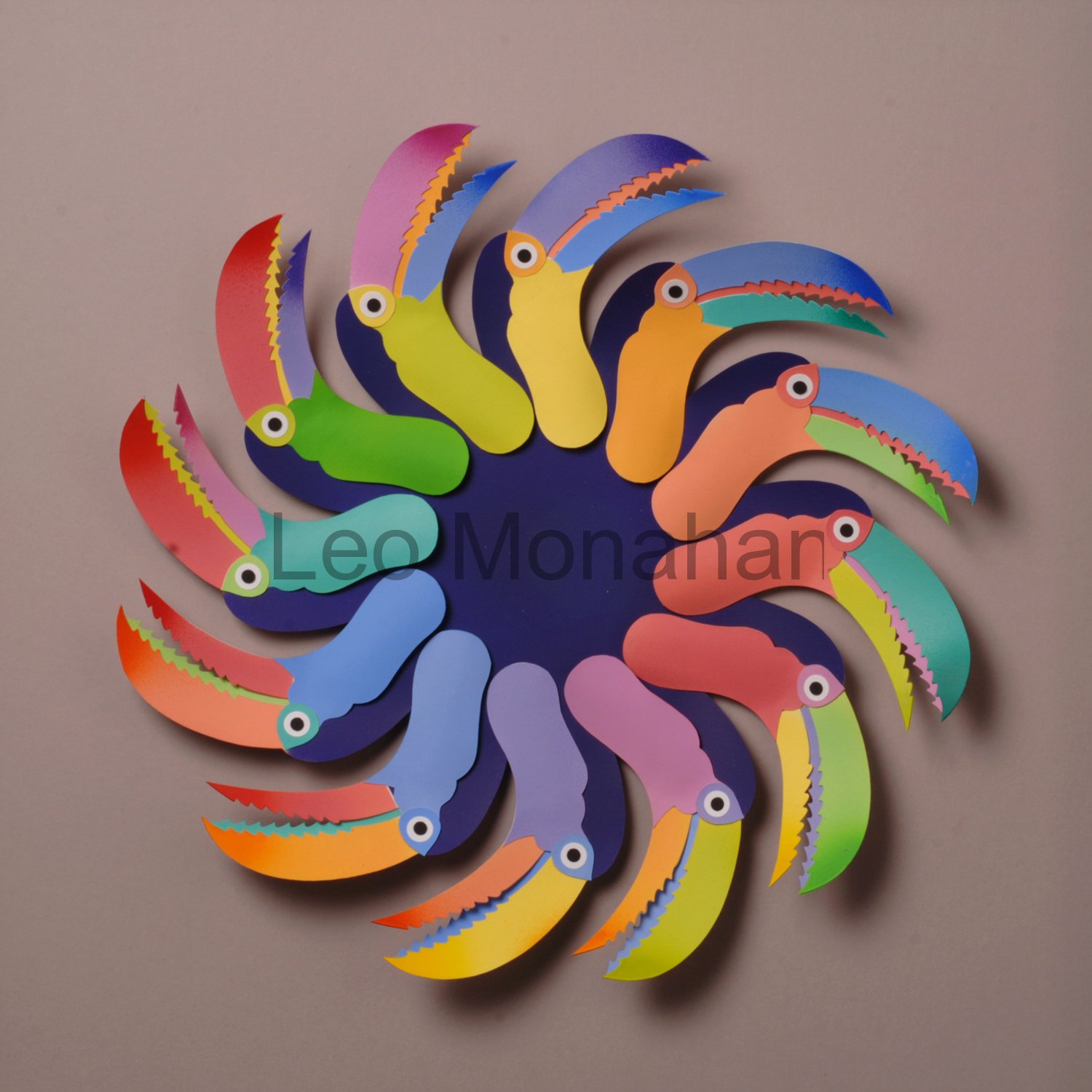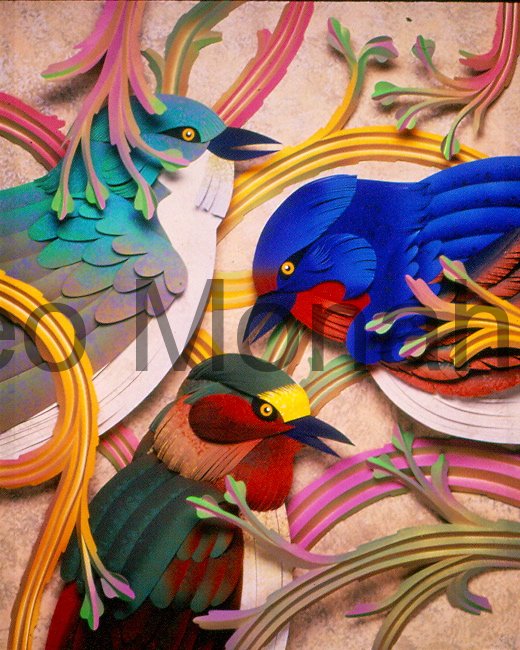Dear Reader,
Birds have always been one of my favorite subjects. There’s a tremendous variety if you want to copy them, and infinite inspiration when abstracting or making up your own versions. Every aspect of the study of color is available in their world. There are seven contrasts of color in the Bauhaus system: contrast of hue (the colors), light-dark contrast (value), cold-warm contrast, complementary contrast (opposites), contrast of saturation (purity), contrast of extension (proportion), and simultaneous contrast (afterimage).
I find the simultaneous contrast the most challenging and interesting of all seven contrasts. If you take a large shape of any color and overlay a small dot or square of a complement, and if you stare at it intensely, you will begin to see a halo of color around the small amount. The eye searches to see the step between, or transition, from one hue to another. As an example, the after image of green on red is yellow. If two similar amounts are laid side by side, a glow will appear where they meet. This effect in color is between two precise complements (opposites). Many birds glow with this effect.
Next time you’re in traffic, stare at the red light and when you look away, you will see an afterimage, and a traffic cop wondering what in hell you’re doing and why you aren’t moving. He might ask if you also see bats and bees whirling around in your head, and ask you to please put your hands behind your back and spread your legs. “Do you have any guns, knives, or hand grenades in your pockets, sir?” I know about this stuff because I went to the academy, became a full-fledged LA county deputy sheriff, and worked patrol and other assignments as a reserve deputy for a dollar a year, for 25 years. Perhaps I arrested you in West Hollywood?

The Toucans are an example of almost every contrast possible. The colors are pure, dark and light, warm and cool; they are used in varying proportions.
The bodies are large amounts of pure color; the upper, lower, and interior of the beaks are complements of the body colors. The shapes around the eyes, small as they are, make up a color wheel. Everything, except afterimage.

Soft breeze, leaves tremble
Like a million hands waving
Anxious birds flutter.
These birds are my fantasy versions of songbirds in an art-nouveau tree limb setting. The colors of the top bird are soft variations of tinted blue green. The bird on the right is a contrast of pure deep blue, red, and red brown. The bottom bird is painted in dark neutrals of greens and reds made by mixing in the complements or adjacent (near) complements. All of them have white breasts that relate to the soft, textured beige of the background. The varying colors of the limbs harmonize with the colors of the birds.
Round and round pell mell
A cat on a carousel
Free rides for songbirds.
That is an after-the-fact analysis of the piece. I did this intuitively and depended on serendipity for my effects. I don’t consciously think about this stuff as I work. I put things in and take things out until it seems to have some element of finish to it. In other words, I abandon it at some point.

This “Rising Swan” is an early piece that has been owned by an old friend in Las Vegas for nearly 30 years. It was done as a cover for a book on paper sculpture. The swan and grasses are cut from 2-ply Strathmore and mounted on heavy watercolor paper. The texture is roughly sponged-on watercolor paint, making the grasses and the water cool, the swan neutral grey, and the background warm.
The thunder at dawn
Rising swan wakes up the world.
Air, water, and flight.
When, in the late 80s, I decided to make fine art, this friend was, in large part, responsible for the direction I finally took. After completing three large, very decorative, white-on-white sculptures, I took them to him and asked for a critique. Although not an artist himself, he was attuned to quality work after years as an advertising agency executive, and I trusted his opinion.
He looked at them for a long time. While acknowledging that all three were beautiful examples of the art, he asked, “Where are you in this?” I looked at them for a long time and answered, “I’m not in this. They’re just pretty pieces of decorative crap that have no meaning; it’s just me showing off.” I know how to do pretty, and they were pretty damn shallow. I didn’t want to have them around, so I gave them to him as a gift of nice pieces of decorative art.
I thought about this for about six months, and settled on my childhood in the Black Hills as the only images for which I had strong emotions. I don’t remember if I gave him the swan or if he bought it, but I’m glad it’s his.
So many years have gone by. I’m not sure that I could do the purely decorative stuff as well now.
Design is still there
Brilliant flashes as before.
But my hand is gone.
Thanks for visiting me…
leo
None of the art shown is available.
There is one piece, Birds Over Autumn (not shown), which is now available as a signed giclee at the Cut, Bend, Fold, ColorColorColor exhibit at the Grovewood Gallery. Edition size of 100. $250.
I am in the Weaverville Art Safari open studios tour May 12-13.
Go to the website for information. www.weavervilleartsafari.com
